Cavan, Co. Cavan
Cavan Poor Law Union was formally declared on 27th November 1839, and covered an area of 279 square miles. Its operation was overseen by an elected Board of Guardians, 30 in number, representing its 23 electoral divisions as listed below (figures in brackets indicate numbers of Guardians if more than one):
Co. Cavan: Arvagh, Ballyconnell (2), Ballyhaise (2), Ballymachugh, Bellintemple, Belturbet (2), Butlersbridge, Cavan (3), Crossdoney, Crosskeys, Denn, Derrylane, Drumlane (2), Kilconny (2), Kildallan, Kill, Killashandra, Killycrone, Killykeen, Kilualeck, Newsun, Redhills, Stradone.
The Board also included 10 ex officio Guardians, making a total of 40. The Guardians met each week on Tusday.
The population falling within the Union at the 1831 census had been 83,604 with Divisions ranging in size from Kildallan (population 2,211) to Cavan itself (7,030).
The new workhouse, built in 1841-2, was designed by George Wilkinson. It occupied a nine-acre site a mile to the north of Cavan town. It could accommodate 1,200 inmates, making it Ulster's largest workhouse. The cost of the building was £10,500 plus £2,000 for fixtures and fittings etc. It was declared fit for the admission of paupers on 26th March 1842, and admitted its first inmates just under three months later on the 17th June. The workhouse location and layout are shown on the 1912 map below.
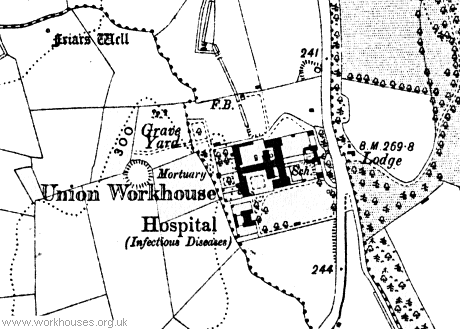
Cootehill workhouse site, 1912.
The workhouse followed one of Wilkinson's standard designs, with a front block housing receiving rooms on the ground floor and a board-room on the first floor.
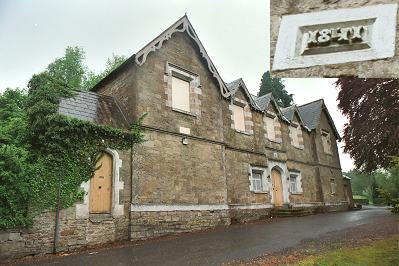
Cavan workhouse entrance block from the south-east, 2002
© Peter Higginbotham.
A three-storey central block house had the master and matron's quarters at its cente. To each side were male and female dormitories, school rooms. .
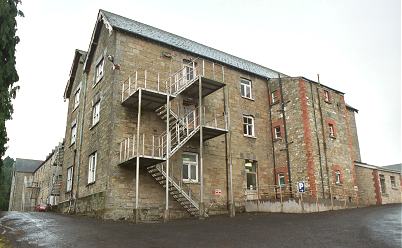
Cavan workhouse central block from the north, 2002
© Peter Higginbotham.
At the rear of the main block was a single-storey range containing the kitchen, laundry, bakehouse and outher utility rooms. A central spine containing the chapel and dining-hall then linked to the rearmost block which housed the two-storey workhouse infirmary.

Cavan workhouse rear of main block from the north, 2002
© Peter Higginbotham.
A small mortuary was located at the east of the site.
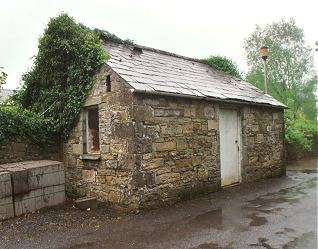
Cavan workhouse mortuary from the north-west, 2002
© Peter Higginbotham.
During the famine in the mid-1840s, accommodation was provided for 40 convalescent patients in sheds. Fever patients were originally catered for by appropriating the idiot and probationary wards. In 1847, a separate fever hospital was built at the south-west of the site. A small block to its rear may have been used as an isolation ward.
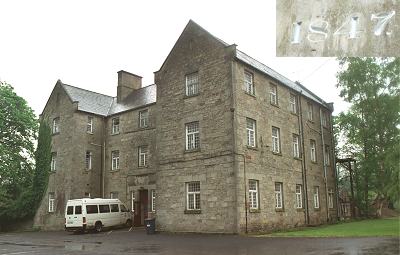
Cavan workhouse fever hospital from the north-east, 2002
© Peter Higginbotham.
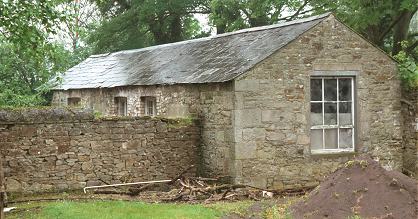
Cavan workhouse isolation block(?) from the north-east, 2002
© Peter Higginbotham.
A graveyard was located to the north-west of the workhouse.
Following the creation of the Irish Free State in 1921, the site became Cavan County Hospital and County Home. It was renamed St Felim's in about 1954, and continued to provided care for geriatric patients. St Felim's was closed in 2003 and the site was put up for sale in 2019.
Records
Note: many repositories impose a closure period of up to 100 years for records identifying individuals. Before travelling a long distance, always check that the records you want to consult will be available.
- Cavan County Library, Farnham Street, Cavan, Co. Cavan. Holdings include: Board of Guardians' minutes (1845-1920); Indoor admission and discharge book (1881-84). Detailed list.
Bibliography
- Down Memory Lane (St Felim's Hospital, Cavan, 1992)
- Crossman, V (2006) Politics, Pauperism and Power in Late Nineteenth-century Ireland
- The Workhouses of Ulster by Michael H Gould, 1983.
- Gray, P (2009) The Making of the Irish Poor Law, 1815-43
- O'Connor, J (1995) The Workhouses of Ireland
Links
- None.
Unless otherwise indicated, this page () is copyright Peter Higginbotham. Contents may not be reproduced without permission.


